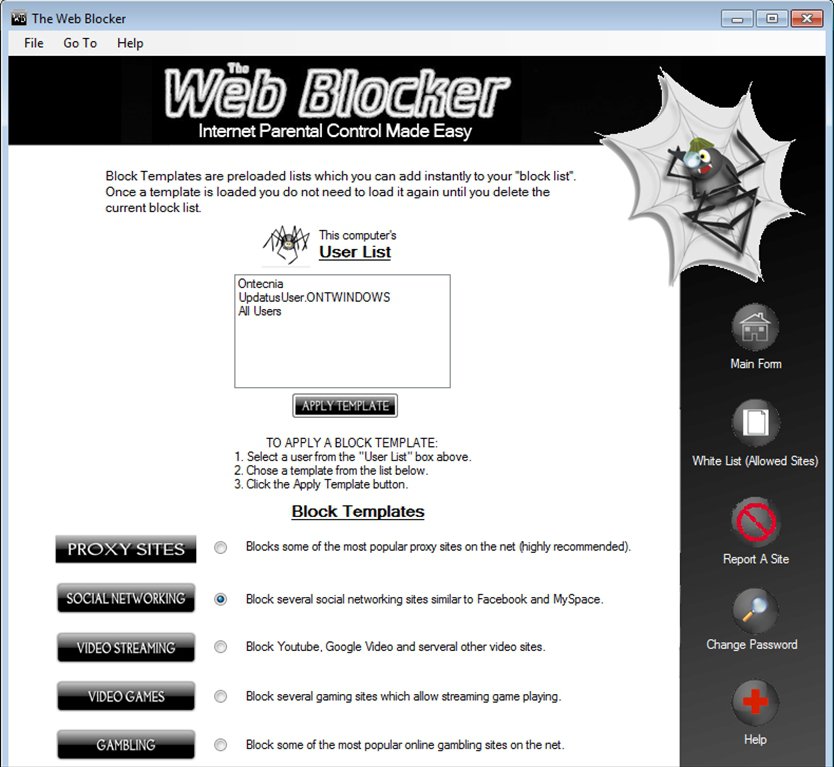

- WEBSITE BLOCKER SOFTWARE ON NETWORK UPDATE
- WEBSITE BLOCKER SOFTWARE ON NETWORK WINDOWS 10
- WEBSITE BLOCKER SOFTWARE ON NETWORK PORTABLE
- WEBSITE BLOCKER SOFTWARE ON NETWORK PLUS
Hosts File Editor is more along the lines of a text editing program that handles the HOSTS file a bit better than an ordinary text editor.
WEBSITE BLOCKER SOFTWARE ON NETWORK PORTABLE
BlueLife Hosts Editor is portable and has separate versions for 32-bit and 64-bit systems. A useful option to get you started is an examples menu that adds block entries for Facebook, Twitter, and YouTube to the list. The add and delete buttons do work in this mode but make sure to highlight the entire line to remove it. The text view is more traditional and shows the entries as a normal text editor like Notepad would.
WEBSITE BLOCKER SOFTWARE ON NETWORK PLUS
Press the plus icon to add the entry to the list and then the green check to save the changes. Add an entry by entering the Hostname first, then select the address from the drop down list (or select resolve the Hostname), and optionally add a comment. Enable or disable an entry by checking or unchecking the appropriate box. The default editor view is a table which makes it easier to add and edit entries to the list. BlueLife Hosts Editor is similar to HostsMan in some ways because it has some additional features, such as import and export lists and a backup manager to backup and restore HOSTS files. Some we’ve mentioned before like DNS Jumper and Firewall App Blocker. Sordum is a developer that makes dozens of useful Windows utilities. A portable version is also available but the main Google Drive download links on the website don’t work, so use the alternative links just below (from Softpedia). Press “Run HostsMan as Administrator” in the main window to make all the editing options become available. On launch, HostsMan won’t ask for administrator privileges but it requires them if you want to do any sort of editing of the Windows HOSTS file. The checkboxes add a hash sign that will comment out (disable) the entry. The editor is pretty simple to use and you can easily add, remove, enable, disable, search (including regular expressions), and edit entries. However, they can be removed and replaced with alternatives, such as the Steven Black HOSTS lists. The only thing that doesn’t work correctly is a few of the included HOSTS lists are no longer available (hpHosts in particular).

WEBSITE BLOCKER SOFTWARE ON NETWORK UPDATE
Sadly, HostsMan ceased development and the last update is from 2017. It can edit the HOSTS file, backup/restore/import/export files, add predefined lists of entries from local or remote sources, sort and manage entries, and exclude specific addresses from being added. HostsMan is a multi purpose tool that can do a number of things in relation to the HOSTS file. Administrator access is required to edit the HOSTS file although you can still view it without such privileges. Perhaps the website has previously been blocked in HOSTS. The HOSTS file is also a good place to look if you are having issues accessing certain websites. Do note that some websites may or may not require If in doubt, you can use both to ensure the block works.īelow is a selection of tools that help you edit the HOSTS file along with adding and removing entries.
WEBSITE BLOCKER SOFTWARE ON NETWORK WINDOWS 10
Using HOSTS has also become a popular way to help block the huge amounts of telemetry sent to Microsoft by Windows 10 and 11.Īs an example, if you want to block the computer from accessing Facebook, simply create a new line in the HOSTS file with the following mapping:ġ27.0.0.1 This will make Facebook inaccessible on the computer (in the web browser and elsewhere), as you can see by watching the short video below. By default, the HOSTS file contains no active mappings (all lines in a default HOSTS file are comments) and most computer users wouldn’t have a need to manually touch the file.Ī common usage of the HOSTS file is to block advertisements, trackers, and malicious websites by mapping a website domain to localhost which is 127.0.0.1. For Windows, it is located in Windows\System32\drivers\etc\ and has no file extension. The HOSTS file is found on every operating system and is used to manually force map a hostname to an IP address without relying on a DNS service.


 0 kommentar(er)
0 kommentar(er)
